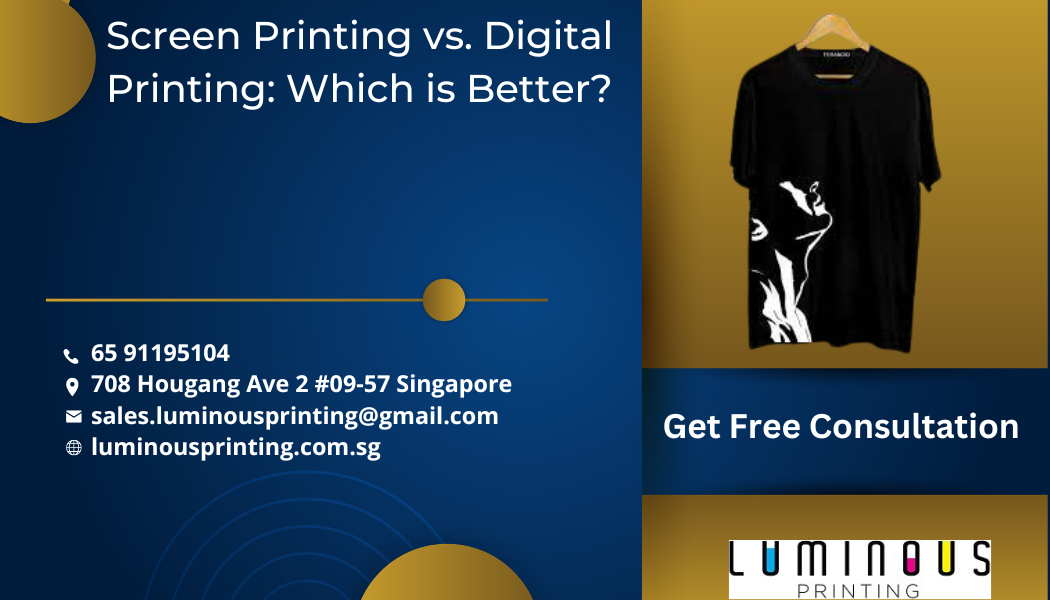Not known Facts About Tx Tees
Not known Facts About Tx Tees
Blog Article
Getting My Tx Tees To Work
Table of ContentsSome Known Incorrect Statements About Tx Tees Tx Tees Can Be Fun For AnyoneTx Tees for DummiesAn Unbiased View of Tx TeesA Biased View of Tx TeesAll about Tx TeesTx Tees Can Be Fun For Anyone
Include up other prices, like the number of utilities it takes to run the store and the cost of ink and solution per style. Take the print listed below.The emulsion ought to just be a couple of cents since you 'd only need to coat one display for this work. How much should you charge per tee shirt to make an earnings? Usually, printers try to make up to 45% profit on a print job. Below's a table to help you identify that: complete price per thing percent of desired profit as a decimal (example:.25 or.45) revenue made per item per job Now let's talk regarding the earnings of DTF.

With DTF, you can publish a handful of shirts, or simply one. Both display printing and DTF have their particular niches in the world.
The Ultimate Guide To Tx Tees
The finest way to understand? Ask about and see what print shops like yours are doing. custom monograming. Try both out and see which you like much better
When you're picking what sort of printing technique to utilize for publishing your art work layouts on your garments, it is necessary that you understand the differences between these 2 methods so you can maximize results while minimizing expenses. Screen printing is the most typically utilized method for printing layouts on fabrics.
DTG printing is likewise referred to as area or straight to garment printing since it prints only what is needed instead of making a screen as display printers do. https://www.magcloud.com/user/txtees02. Display printing works by display filler squeegee display printing ink screen mesh display, then moving the image to garment making use of heat and/or stress
The DTG printer uses unique dye-sublimation inks that are applied right into a pre-designed picture by an electronic printing system. The inks end up being component of the fabric, permitting for dynamic shades and extraordinary information. It's also called place or direct to garment printing since it publishes only what is required as opposed to making a display as screen printers do.
See This Report on Tx Tees
First, it's much faster - you can print a fullcolor picture in mins, in contrast to hours for display printing. Second, there's no established up time or prices entailed - you can publish any kind of layout you such as, without having to develop a display. Third, there's no waste - due to the fact that display printers display print one style each time, they have to screen each color separately.
The paper is really costly and can only be utilized once. Once it's printed on, it needs to be discarded. - The initial acquisition rate is reduced than the ahead of time financial investment of DTG printers- You can publish multi-color styles one screen at a time rather than needing to publish each color separately like DTG printing.

The Facts About Tx Tees Uncovered
However, as opposed to making use of display mesh as screen printers do, dye sublimation printers make use of laser technology to transfer your pictures onto garments or paper. A heat process transfers the color from its solid-state straight right into the gas stage which consequently merges it onto fabric substrates when they are rapidly heated to heats under high stress.
Sublimation printing is eco-friendly. It utilizes much less water than screenprinting, and due to the fact that it does not entail using damaging solvents, it's risk-free for all kinds of garments. The color sublimation inks are additionally odorless when cured, unlike screen printers that use damaging chemicals during the screen printing process that leave behind an unpleasant odor.
They likewise save money on costly equipment like exposure units because dye sublimation printers do not need a UV exposure unit or a flash treatment stove that is commonly used in screen printing (custom monograming). What is straight to garment printing (DTG Printing)? DTG printing is an electronic screenprinting procedure that prints directly onto fabric using specialized inkjet printers
The smart Trick of Tx Tees That Nobody is Discussing
DTG printing offers several advantages over conventional screenprinting, consisting of the capability to print photo high quality images, better color vibrancy, and the capability to publish designs on darker textiles. DTG printers work by warming the fabric ink until it transforms into a gas. The gas after that permeates the textile, bonding with the fibers to create an irreversible print.

Screen printers simply prepare their screen after that begin publishing up until they run out of product or ink.- There is a large range of experienced display printers around the world, which can be valuable for beginners. - It's a slower process - display printers usually need to wait on the ink to dry before they can publish the following color- Display printers need manual work, so there's a higher learning contour and it takes longer to create a premium design- Display printing isn't as precise as DTG printing, so you might get some "bleeding" of shades from one part of the picture onto one more otherwise done effectively.
Our Tx Tees Ideas
Instead of making use of screen mesh as display printers do, color sublimation printers utilize laser modern technology to transfer your pictures onto garments or paper. A warmth process moves the color from its solid-state directly right into the gas stage which in turn integrates it onto fabric substrates when check out this site they are quickly heated to heats under high stress.
Sublimation printing is environment-friendly. It makes use of less water than screenprinting, and since it doesn't involve making use of hazardous solvents, it's risk-free for all kinds of apparel. The color sublimation inks are also odor-free when cured, unlike screen printers that utilize unsafe chemicals during the screen printing process that leave an undesirable smell.
They also save money on expensive devices like direct exposure devices since dye sublimation printers don't need a UV direct exposure device or a flash treatment oven that is generally utilized in screen printing. What is straight to garment printing (DTG Printing)? DTG printing is an electronic screenprinting procedure that publishes straight onto textile making use of specialized inkjet printers.
The Definitive Guide to Tx Tees
DTG printing offers many advantages over typical screenprinting, consisting of the capability to print photographic quality photos, higher color vibrancy, and the ability to publish styles on darker materials. DTG printers work by warming the fabric ink up until it turns right into a gas. The gas then penetrates the fabric, bonding with the fibers to develop a long-term print.
Report this page